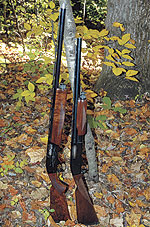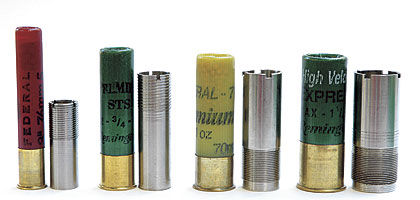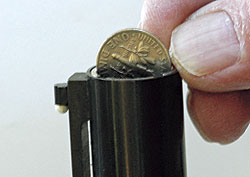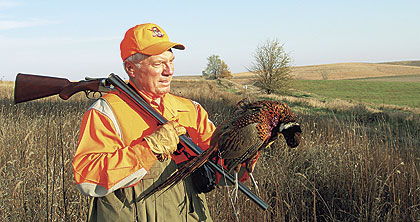Old myths die hard
By Layne Simpson
 A longer barrel improves the handling qualities of a shotgun and puts muzzle blast farther away from the shooter's ear, but it does not increase muzzle velocity enough to matter. |
Down through the decades all sorts of fallacies about shotguns and shotgunning have emerged from the bushes. Some immediately wilted on the vine while others have been kept alive by generations of hunters. Some have stood the test of time while others have gone from fact to fallacy. Here, then, is a modern look at a few of my favorites.
A Long Barrel Shoots Faster Than A Short Barrel
This one was born many hunting seasons ago, back when shotshells were loaded with black powder. Whether or not that opinion actually held water in those days may never be known for certain but I have serious doubts.
It is a proven fact that most modern shotshell propellants with their progressive burn rates are entirely consumed in a barrel no longer than 24 inches and since the various grades of black powders loaded in shotshells in the old days burned more quickly than today's modern powders, I doubt if long barrels ever shot a great deal harder than short barrels.
In fact, the ability of black powder to burn almost instantaneously rather than progressively is why it was once used as an explosive in the mining and construction industries. Velocity tests I performed a few years back convinced me that a short barrel does not handicap shotshell performance.
Several years ago Remington introduced a snubnosed version of the Model 870 pump gun with a 22-inch barrel and called it the Special Field. In those days I did a lot of my turkey hunting in heavily forested mountain country and due to its short overall length and light weight, I used a Special Field for a lot of it.
Curious about how much velocity I was losing with its short barrel, I rounded up a variety of loads and spent a day in front of an Oehler chronograph with that gun and another gun with a 28-inch barrel. As I discovered, a couple of the three-inch turkey loads were 25 to 30 fps faster in the longer barrel but various target and field loads clocked about the same velocities in the two barrels.
 Everything including choke constriction percentages being the same, all gauges deliver patterns of about the same diameter at various distances. |
A longer barrel can and often does improve the handling qualities of a shotgun and it also shifts muzzle blast a bit further from the ears of the shooter but any increase in length beyond 24 inches seldom has a significant effect on shotshell performance.
Use A Dime To Check The Amount Of Choke
Have you ever been cruising the aisles of a gun show and seen an old-timer pull a dime from his pocket and use it to check the choke of a 12 gauge shotgun barrel? As some shotgunners have long believed, if a dime will not fully enter the muzzle of the barrel it is choked Full. By the same token, if the dime will enter the barrel it is choked looser than Full.
There are those among us who take great joy in ridiculing the old dime-check routine but they only show their ignorance in doing so as there is a great deal of truth in it. It works on older guns because there was a time when bore diameter for the 12 gauge seldom exceeded .730 inch.
Back then, Full choke meant .040 inch of constriction, which put bore diameter at the muzzle at .690 inch. A dime in good condition will measure anywhere from .703 to .705 inch in diameter so it takes no mathematical genius to understand why it will not fully enter the muzzle of an older gun.
On the other hand, if the bore at the muzzle is constricted .020 inch, which has long been standard for Modified choke, it is reduced to only .710 inch, which is larger than the diameter of a dime.
Even though the standard amount of constriction for Full choke has since been reduced to .035 inch, the old method works equally well today so long as bore diameter is held close to .730 inch. But it does not work on overbored barrels, with the barrel of my Remington Model 90-T trap gun a good example.
 Using a dime to check the amount of choke in a barrel--a method often advocated by old-timers--has more truth to it than those who ridicule it realize. |
Even though its barrel is choked Full, it has a bore diameter of .745 inch and measures .710 inch at the muzzle so a dime will slip right in with room to spare.
The .410 Shoots Harder Than The 12 Gauge
I am not sure how this one got started but I often heard it as a youngster and it may have had something to do with the fact that guns in .410 were customarily choked Full in those days.
We now know that for general wingshooting the .410 is best choked Improved Cylinder and Modified, same as for the larger bores, but for some odd reason most guns chambered for it in the old days were choked Full. And since a tightly choked .410 is likely to put more pellets into a rabbit or quail at 20 yards than a loosely choked 12, the higher energy it delivered to the target may have made it appear to hit harder.
Had apples been compared to apples it would have been easy to have seen that when both are choked the same the 12 gauge hits harder simply because it delivers more pellets and therefore more energy to the target. Assuming the same pellet size and muzzle velocity for the two, each individual pellet fired by the .410 and 12 gauge delivers the same exact level of energy but since the typical 12 gauge shot charge contains a greater number of pellets it holds an edge in total energy delivery to the target.
The 12 Gauge Shoots Bigger Patterns Than Smaller Gauges
Absolutely not true.
When choke constriction percentages are the same, all shotshells ranging from the .410 to the 10 gauge shoot patterns of about the same diameter so long as the same style of wad and shot of the same hardness are used.
The larger the gauge the higher will be pellet density within the pattern simply because the standard shot charge of a
larger gauge contains a greater number of pellets than for a smaller gauge, but all else being equal, the diameters of the patterns will be close to the same.
The key word here is choke constriction percentage.
 The author's 1920s vintage Fox Sterlingworth is proof that all old shotguns don't have crooked stocks. |
For the 12 gauge, .035 inch of constriction is standard for Full choke nowadays and assuming a bore diameter of .730 inch, this puts the percentage of constriction at roughly 4.8 percent. If we apply that same .035 inch of construction to the barrel of a 28 gauge gun with a bore diameter of .550 inch we are at 6.4 percent, which is far off the chart.
To arrive at 4.8 percent or Full choke for the 28 gauge we would choose a choke with about .010 inch less constriction than for the 12 gauge or .025 inch of constriction. At that point, barrels in those two gauges should be shooting patterns of the same diameter at various distances.
All Old Shotguns Have Crooked Stocks
Many do but some don't.
As a rule, the stocks of shotguns built prior to World War II have what we now consider to be excessive drop at their comb and heel.
The same holds true for a few guns built as late as the 1950s. But there have been exceptions.
As early as the 1920s, anyone who ordered a shotgun from Fox could pay an additional $5 for any reasonable change in stock dimensions. And this was offered on all grades of guns. My Sterlingworth was built during the mid-1920s and yet its stock dimensions are as modern as you will find on any gun made today.
Another example is my 16-gauge L.C. Smith. During the 1940s my father and his brother bought identical L.C. Smith doubles except Dad's was in 16 gauge and Uncle Tobe's was a 12 gauge gun. Both were brand new at the time and according to their serial numbers they were built during the same year.
I now own my father's gun and its stock has modern dimensions. On the other hand, my cousin has his father's gun and its stock has excessive drop at comb and heel. Like I said before, some do and some don't...go figure!






